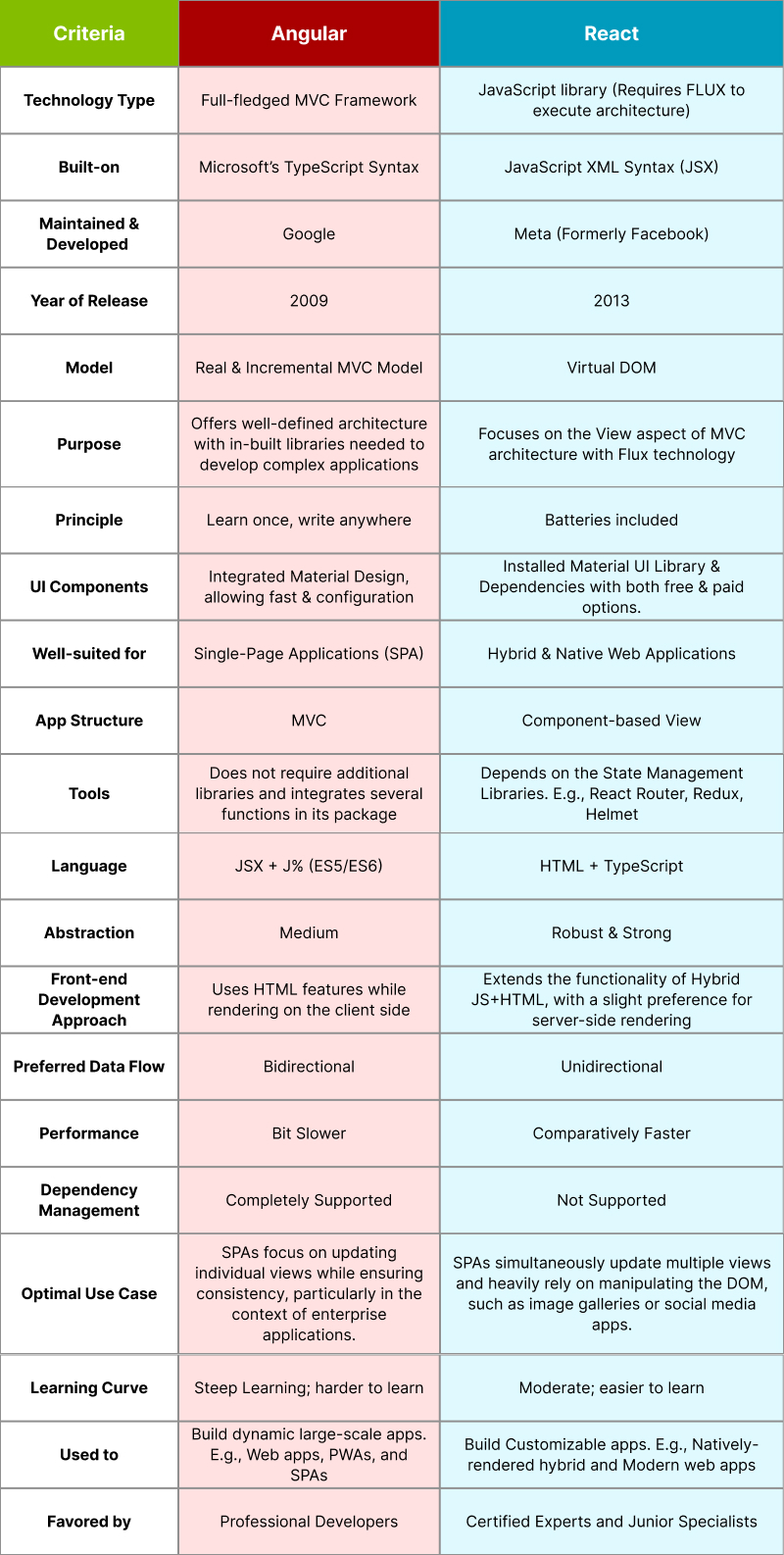
As technology continues to advance exponentially so does the web development field! The moment you plan to proceed with your next application, a plethora of options might confuse you. For the same, we have tried to highlight a precise comparison between the two most prominent front-end frameworks. The debate over this topic occurs almost whenever front-end programming is needed. Undoubtedly, both frameworks facilitate faster functional front-end development. JavaScript developers have been using Angular and React for years to build web and mobile applications. As per a recent survey from StackOverflow Developers, these two are considered the most utilized frameworks by software developers all around the world.
So now the question arises, which is the best among the two?
To understand which framework to choose for your next project, read below, and analyze the differences between the frameworks mentioned above. You can also hire top developers to derive proper knowledge of the two-specified frameworks.
- About Angular- Key Features and Benefits
- About React- Key Features and Benefits
- Comparison at a Glance: Angular vs React
- Popularity & Preference Check: Angular vs React
- Components Check: Angular vs React
- Data Binding Check: Angular vs React
- Angular vs React: When to Choose What?
- Which one is better for Web App Development?
About Angular- Key Features and Benefits
Angular is a frontend open-source JavaScript client-side framework maintained and developed by Google since 2010. It leverages the capability of TypeScript programming language to build robust and scalable web and mobile applications.
This element-based framework was remodeled from Angular 1.0 (Angular JS) to Angular 2.0 (Angular) in September 2016. Further, the 101.3 version of Angular was introduced in the market in September 2020. This presented a rewrite of the original framework, with an updated algorithm for dependency injection and two-way data binding.
The recent version of Angular 14 (Angular v16) was released in June 2023 with well-integrated functionalities. Not only this but also, it includes a set of developer tools, majorly used by Custom mobile app development companies to expand and create enterprise-grade applications.
Key Features of Angular
- Angular CLI: If you hire AngularJS developers from us, they use CLI to frame the project structure, generate modules, and automate various developmental tasks.
- Testing: End-to-end testing is performed in a protractile manner by fragmenting the program into small snippets. This helps to ensure the accuracy and behavior of the source code.
- Two-way Data Binding: Two-way Data Binding simplifies the data synchronization procedure between the component and the prototype view. It mainly handles data manipulation and user interactions.
- Built-in Libraries: The wide range of built-in libraries and modules greatly helps develop custom software applications. For instance, it facilitates major developmental tasks, like, form validations and reactive programming.
- Dependency Injection: This exclusive functionality helps to simplify the management and dependency across various components and services.
- HTML Templates: Angular has many powerful templates that help define the user interface's structure and layout.
- Routing with @angular/router: With the built-in router module, developers define routes, handle URL parameters, and optimize the loading time of any application.
- MVC Model: The MVC architectural pattern provides a structured way to develop the applications.
- Component CSS encapsulation: This feature ensures a clean and isolated styling environment, preventing component conflicts.
- XSS Protection: The cross-scripting attacks automatically get prevented through security measures.
- Virtual Scrolling: This feature dynamically renders and loads the visible portion of any list, improving memory usage and performance.
Benefits of Angular
In Angular, everything happens under the same ecosystem. Let’s unravel the benefits of utilizing Angular Framework.
1. Out-of-the-Box Functionality
Access to Angular libraries and robust template solutions aid in standardized navigation. Consecutively, Angular also offers a comprehensive MVVM framework that encompasses a wide range of features, such as dependency injection, two-way data binding, routing, forms, templating, and security, providing developers with a complete set of tools and functionalities.
2. Comprehensive Documentation
Angular offers comprehensive documentation to guide developers. In many cases, detailed documentation is considered the best way to develop a grasp of any language. Hence, rather than searching in different places, you can approach us. We are one of the leading AngularJS development company, and we can help with full-stack web development solutions under just one roof.
3. Reduced Coding
Angular helps in clean code development, eliminating errors in the entire development cycle. The reduced coding time helps to build blazingly fast apps. Apart from this, Angular also helps to structure the application’s functionality, dividing elements into reusable pieces and features.
4. Intuitive App Structure
Angular encourages a scalable application structure, dividing the application into reusable components, modules, and services. The improved app structure facilitates strong encapsulation, where every single page can be created separately and combined later to view the final product.
5. Interactive UIs
The primary benefit of using Angular is Interactive UIs, which are essential for data binding. You can hire AngularJS developers to build large-scale applications. Also, the framework includes in-built stunning themes that can be simplified and customized according to the user’s requirements. For example, e-commerce applications, Progressive Web Applications, etc.
6. Reusable Components
Angular expands the capabilities of HTML Syntax by introducing directives, enabling developers to build reusable components. Due to this, the UI configuration becomes faster and simpler.
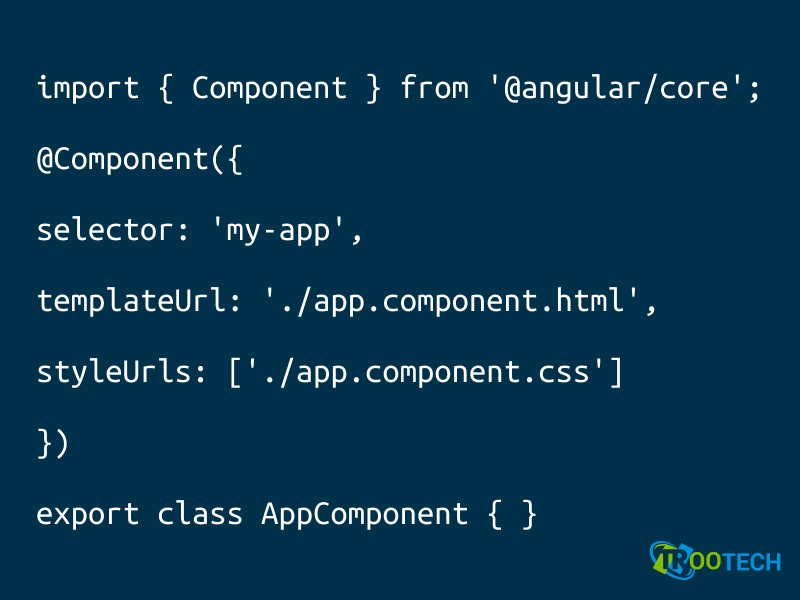
About React- Key Features and Benefits
React is an accessible open-source front-end JavaScript library developed by Facebook in 2013. It provides a declarative syntax to build user interfaces and mainly follows the “Learn Once, Write Anywhere” principle. Also, it primarily operates on client-side rendering through a DOM to create and debug UI components. Apart from this, it also focuses on server-side rendering to offer a performance-based solution to the users.
Initially, it was introduced by Facebook and later used on the Instagram website before making it available to the public in May 2013. Subsequently, following the core functionality, React was again released as React 16.8 on 6th Feb 2019. The latest version, i.e., the 18th version, was launched in March 2022 and included automatic batching, Concurrent React, and a few transitional APIs.
Over time, not just a JavaScript library, but a framework, React expanded its ecosystem with additional tools, such as React Router and Redux, commonly used to build interactive and complex UI components.
Key Features of React
- One-way Data Binding: React libraries help handle state management and immutable data. All of these help to achieve an unidirectional data flow.
- Faster Development Time: The modular and coherent components in React simplify and accelerate the debugging process.
- JSX Advantage: React uses a syntax extension called JSX, which combines JavaScript and XML-like syntax. JSX allows developers to write HTML-like code within JavaScript, making it more convenient and intuitive to work with.
- XSS Protection: React provides built-in protection against XSS attacks. Even strong community support helps it remain secure and updated per the latest trends.
- Virtual DOM (Document Object Model): The Virtual DOM optimizes the rendering process, facilitating faster updates.
- Declarative Views with Context APIs: The view-oriented framework allows the sharing of data across components, enabling the management of desired UI states in a declarative manner.
- Isomorphic JavaScript: As you hire ReactJS developers, they keep on adding isomorphic features, making React an extensive JavaScript library. Leveraging the same, they execute JavaScript code both on the server and the client.
- Building Blocks Flexibility: React can control the flow of colossal applications in a flexible manner, leading to enhanced scalability.
- Component-based Architecture: React uses reusable, imported components, which facilitate effective custom mobile app development. With this, you can also maintain and manage a code by assembling it into self-contained pieces.
- Community and Ecosystem: The pre-built components in React help to speed up the development process. Also, the vibrant ecosystem includes a vast number of tools and resources needed for documentation.
- Visual Design: React facilitates developers to use the lower level of algorithms and creates engaging interfaces in the least amount of time.
- React Native: Without a hitch, custom software development is facilitated by React Native. Developers can deploy the same code on various platforms like Android and iOS.
Benefits of React
Indeed, React simplifies the process of creating a complex UI or seamless UX. Take a look at the benefits you can avail after you choose React as your App’s framework.
1. Enhanced Web App Performance
The most significant advantage of React is its ability to improve web app performance. By utilizing ReactJS on the server with the virtual DOM function, search engines can easily crawl and index the content published on a web page. Also, developers can create reusable components that integrate with the main content, increasing overall visibility. This virtual DOM optimizes a website's performance, resulting in faster loading time with improved rankings.
2. Highly Customizable
React offers exceptional customization options. You can hire ReactJS developers to shape the framework according to your requirements. Also, it’s worth noting that with React, developers have the freedom to choose the best-suited architecture. The Modular architecture helps to maintain and update the applications and allows them to break down into smaller components.
3. Simplified Development Process
Advanced trends have revolutionized ways to construct and conceive dynamic apps for the web. This has resulted in a rise in demand to hire ReactJS developers capable of leveraging contemporary technologies. Besides, the reusable components act as go-to UI solutions for developers, helping them with scope testing using native tools.
4. Shallow Learning Curve
React’s rich component availability and formatting style offer a gentle learning process. Only knowledge of HTML and JavaScript is needed to adopt and implement it. To experience the same, you can hire developers from any ReactJS development company, and avail help for your project.
5. Reliable and Compatible
React is a reliable framework that works well with clean abstractions. Users never need to bother about complex functions. Also, the framework is quite compatible to work on Android and iOS. Hence, underscoring its reliability, React is considered one of the most popular choices for front-end development.
6. Versatile and Faster
The React library can be considered the foundation for data dashboards, cross-platform apps, and PWAs. Hence, you can leverage the Create React App (CLI) Tool to bootstrap a code. Again, to test an app, developers utilize multiple code editors. Similarly, React 360 is put forth to create interesting AR and VR apps. Continually, the reduced coding advantage facilitates faster interaction, leading to reduced loading time for any application.
Your Business Growth is a few clicks away!
TRooTech has access to every technology for your custom app development. Get world-class infrastructure by growing your business with us.
Popularity & Preference Check: Angular vs React
After a precise comparison, let’s unveil a few other checkboxes to understand both frameworks better.
Popularity: Angular vs React
Web development is an ever-evolving field, with applications becoming more advanced day by day. Programming in web development is mainly associated with developers. Hence, the more experts are engaged in technology, the more resolutions, tutorials, and support you can expect. Let’s verify which framework tops the model as per various communities.
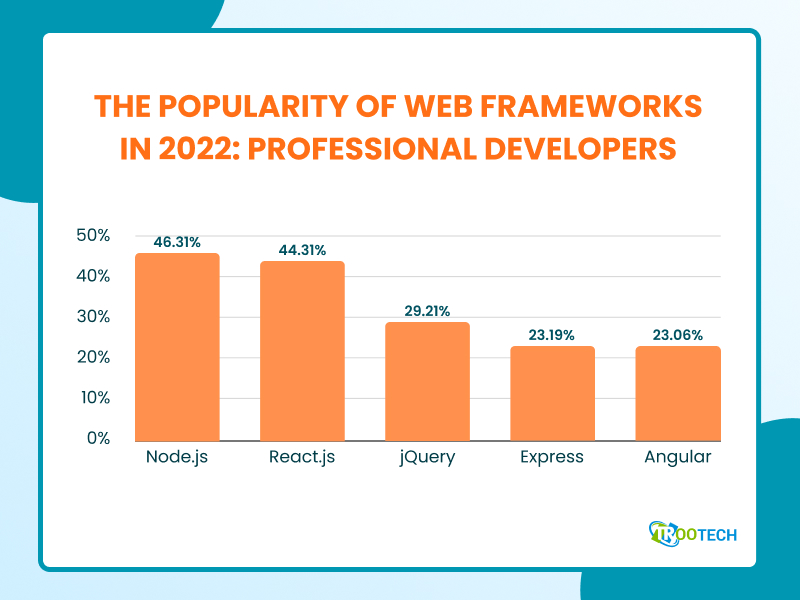
According to the results from Stack Overflow Developer Survey conducted in 2022, React was the most used JS framework with 44% of professional developers utilizing it compared to 23% of Angular.
Furthermore, React has been the favored option among beginners learning to code because of its reduced entry barrier. Hence, the statistics reveal 42% of beginners choose React, and just 10% choose Angular. Based on these findings, it's clear that React is a popular choice among experienced developers and beginners.
Again, Statista Survey in 2022 reveals React outranks Angular, securing the 2nd-most position. Again, if reviewed by GitHub ratings, React wins the game with 207k+ stars, while Angular has only 88 k+ stars.
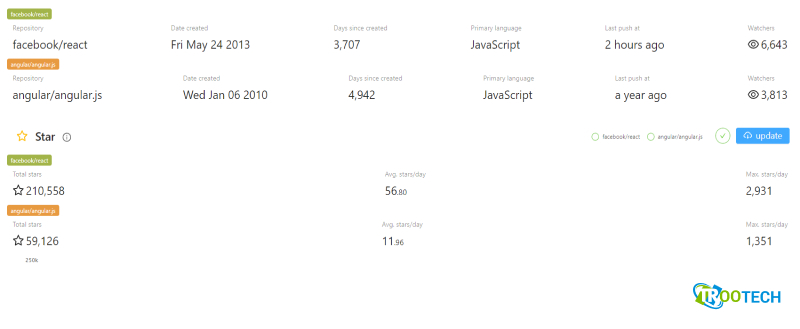
If you are planning to adopt ReactJS as your next framework, look no further and hire ReactJS Developers from us to build highly scalable web apps for your business.
Preference Check: Angular vs React
As we’ve discussed the characteristics above, making a choice between Angular and React can be a bit perplexing, as both frameworks have unique abilities and approaches. Hence, the preference for choosing one between the two completely depends on individual opinions, prior experience, and project requirements. Read the factors below to understand the comparative overview of both frameworks before making an informed decision.
A. Performance/Deployment Speed
Performance is the most important aspect to consider when comparing Angular vs React. Though Angular tends to perform better, React still shows an advantage in the reduced loading times. This is pretty evident, as React uses a Virtual DOM, offering a stable runtime environment. At the same time, Angular manipulates the DOM in a bidirectional way, where regular monitoring is essential.
Again, the change detection system in Angular is very different from React. It automatically changes the view, influencing the app's performance throughout the system.
Check out the table below for a detailed understanding of both frameworks.
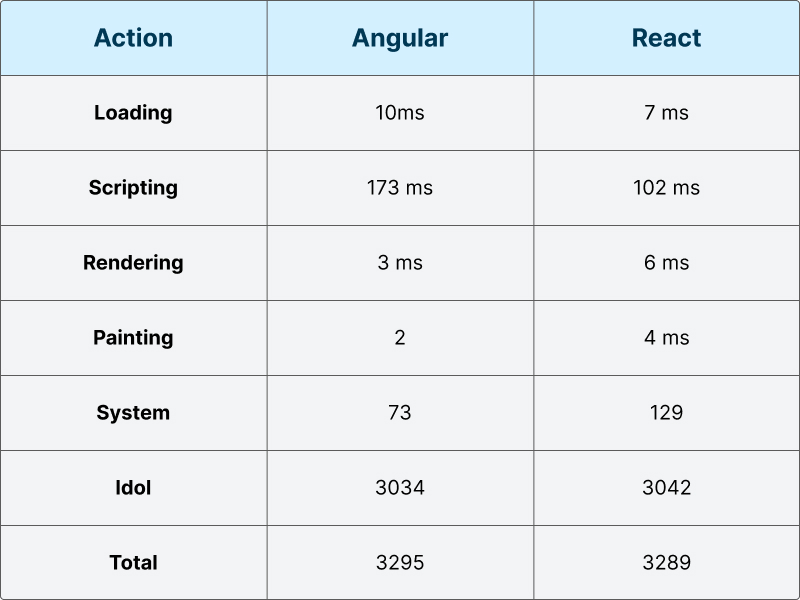
B. Templating
Another important parameter to compare Angular and React is analyzing the directives and templates for web applications. Each directive in Angular is complex, making all the templates extremely traditional and rich with snippets of Angular-specific expression evaluators.
Nevertheless, in React, templates and logic are explained at the end of the component. This makes it simple, easy to understand, and reliable even for perplexed readers.
C. UI Rendering
Rendering actually means binding of the data into template strings to generate the HTML DOM required to display components. Hence, regardless of the complexity of any application, loading time is possible for both Angular and React. This is attainable due to the availability of server-side and client-side rendering. Fundamentally, React uses a Next.js library to render server-side components before flashing them to the client. On the other hand, Angular uses an in-built server-side engine, known as ‘Angular Universal,’ considered the best pick for performance optimization and server-side data fetching.
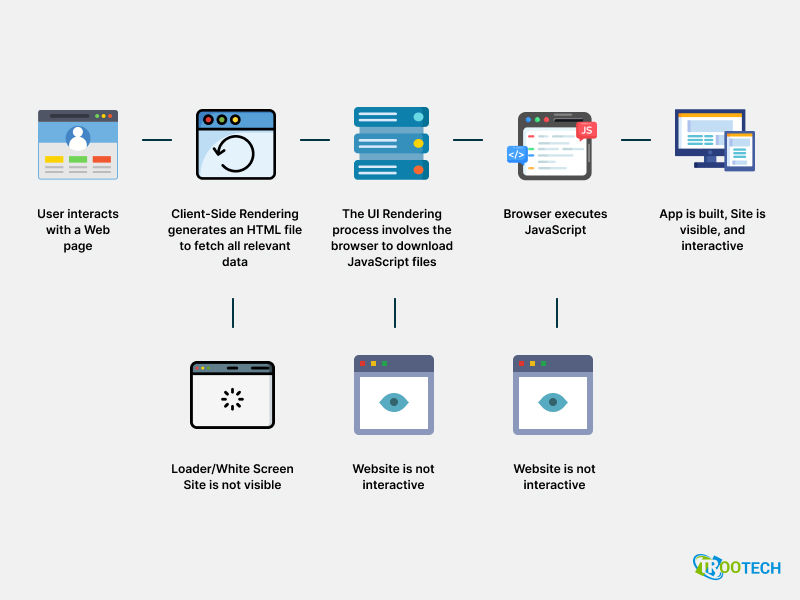
D. Code Quality
As a reputed Custom Software development company, we employ tools like AngularCLI to build and maintain top-performing Angular applications. Apart from this, modular integrations like Angular Material and Angular code have facilitated our AngularJS projects' smooth delivery. On the other hand, React emphasizes on code consistency and maintaining code quality. The identical coding practices in React, along with Display Name strings for debugging and code review practices enabled by Linters, help to develop reusable components. This makes it quite easy to render the uncontrollable input fields with unique naming conventions.
E. State Management
State management is often referred to as the ‘Brain’ or ‘Central Processing Unit’ of an application. In React, every individual component manages its own state. Primarily, REDUX and Recoil are used as state management libraries. Nevertheless, you should hire ReactJS developers to employ React Hooks in your web app. Coming to Angular, NgRx (FLUX/REDUX) permits the use of reactive state management while handling asynchronous events and updates.
F. Accessibility
As technology expands, the app must also actively grow. So, it’s better to check the front-end feature of the application and its compatibility. Adhering to the same, React offers various tools and features with the help of tools and libraries. Also, if needed, users can set ARIA attributes to enhance accessibility. Whereas, in the case of Angular, features, and tools remain disabled for the users. However, ARIA attributes are defined using an in-built accessibility kit.
G. Real-Time App Development
If you plan to build a personalized app that captures real-time data, then count on Angular. The RxJs library in Angular manages real-time communication between the back and front ends. Contrarily, React lacks in-built functionality for real-time data updates. Nevertheless, it supports third-party libraries like Pusher or Socket.io to facilitate real-time data tracking. For instance, the popular recipe app "Foodie Delights" used Angular to incorporate real-time recipe suggestions, and the project yielded impressive results.
H. Version Updates
It’s evident that users will choose the more updated framework with the recent modules and technologies. Acknowledging the same, React allows you to update the older and app versions instantly. Conversely, Angular asks for the installation of the updates of the older versions but in consecutive leaps. Hence, without any doubt, React surpassed Angular in this regard, emerging as the first choice of developers.
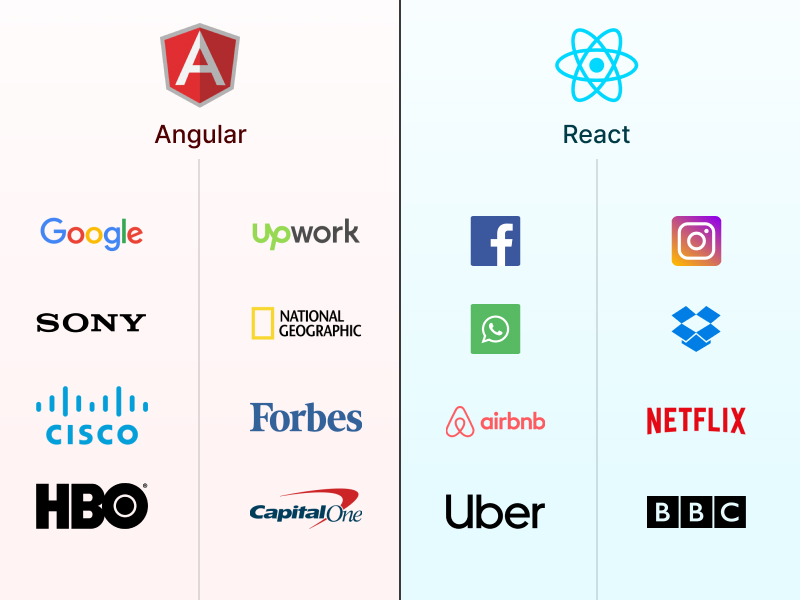
Components Check: Angular vs React
The dire need to segregate front-end frameworks into encapsulated components without breaking the rest of the app is the main idea behind componentization. The component-based architecture for both frameworks, i.e., React and Angular, are used to set up MVVM and MVC.
Let’s check the componentization of both frameworks individually.
Angular
The Angular Framework consists of
- i.) Models: This represents the data and business logic of the application.
- ii.) Views: This presents the user interface and displays data to the user.
- iii.) Controllers: These are used to handle the logic and behavior of the application.
Besides the components mentioned above, few-mode readymade components are utilized by this framework. The most important of all the other components is the code-splitting module pattern, used by developers for project setup, editing, testing, and rendering.
Let’s have a better understanding of each tool.
- Project Setup: With CLI (Command line interface), Angular facilitates the addition of new features. Also, the open-source MIT license makes it suitable for personal and commercial use.
- Rendering: As both server-side and client-side rendering is available consecutively, the optimized loading time is achievable in Angular, regardless of the app’s complexity. Hire AngularJS developers from us to ensure an uncompromised rendering performance in your application.
- Testing: To ensure the compatibility and accessibility of the app, Angular offers comprehensive testing capabilities. Major tools like Karma, Protractor, and Jasmine are used for running and executing code.
Combining these components can help developers divide codes, making it easier to reuse codebases and templates for other projects.
React
Unlike Angular, and React allows developers to write test codes using a declarative approach. There’s no fixed format in writing codes, so component trees make the code logically organized. Majorly it is based on:
- i.) JavaScript Code: The JavaScript language syntax of React offers a structural rendering method for developers to comprehend the code easily.
ii.) ‘V’ aspect of MVC(Model View Controller): This aspect is necessary to provide a seamless UX and an appealing UI in each application.
iii.) Code Linters: The coding techniques in React allow developers to prepare a list of rules before writing the code.
Apart from all these, a few functional components receive ‘props’ as input, used to create reusable UI elements. Code optimization is essential to build performance-oriented UIs for modern applications. So, let's delve into the intricacies of each tool.
- Code Editing: Though CRA (Create React Apps) is used for project setup, other popular options for code editing in React include, Atom, Sublime Text, and VS Code.
- Server-side Rendering: The Next.js framework library, along with the rendering engine, is used in React to manage and check the front-code code interaction with updates, respectively.
- Computed Properties: In React, the computed properties help to encapsulate the logic behind deriving values on the existing state. Hence, instead of manually editing the same, React uses @computed from MobX to achieve a similar objective with a better API.
All these explicit tools and functions, if combined, can help developers save time by reusing them throughout the entire application.
Data Binding Check: Angular vs React
To get a clear picture of the UI of an application with its data model, it is necessary to understand the data binding capabilities in a pre-defined environment. For instance, choosing between colors and fonts in MS Excel and Word using the ‘Text Formatting’ feature. So, automatically, the output will get displayed with the selected font. This shows the establishment of a data connection following a declarative format.
However, to synchronize the UI components to the data sources in the backend of your application, both React and Angular employ two different kinds of data binding.
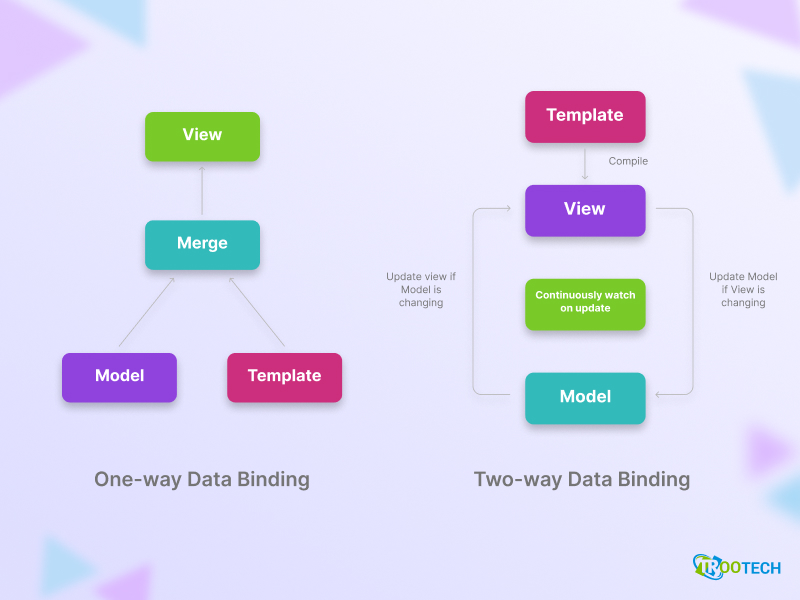
Angular
Angular uses a powerful mechanism to keep the state of view and model in sync, following a two-way data binding model. This method reduces the amount of boilerplate code required to upgrade the view when the model changes. Also, developers can leverage it to build responsive and dynamic applications.
Apart from this, the mutable data binding ability enables applications to produce real-time updates after a proper interaction with the user. The same way works vice versa with the responding interface element and the corresponding underlying state, following both the uni and the bi-directional flow.
Generally, the technique goes as binding the model variable with the HTML Element while making changes in the backend. You may/may not hire AngularJS developers for the same. So, without the intervention of an expert, interactive UIs can be created easily.
Again for faster rendering, the optimized bundled data in Angular can effectively augment the app’s performance. Though this bi-directional model might seem beneficial at first glance, it can make things complex to detect the exact source of the problem.
React
React follows a uni-directional approach, where developers can update the model state to modify UI elements. In simple terms, React breaks down each component into complex structures to perform desired functionalities. To bring all components to action, multiple support tools and integrations like Redux (State Container), WebPack (Module Bundler), and Babel (JSX into JS transpiler) are used.
Data synchronization, one-way, enhances the framework's flexibility and makes it more compatible. This helps developers to nest child components with parent-level components while developing a React-powered application. To put it another way, data travels in a single direction when the model and view are contemporized. In a simpler way, any changes in the component are reflected in view and will change the component’s properties.
Also, with the above, the immutable data paradigm in React makes the app code more stable while helping it to debug faster. However, if you want to implement bi-directional data binding in React, then you can hire ReactJS developers from us at TRooTech. We’re a trusted ReactJS development company backed by highly skilled ReactJS developers who can help bring your business ideas to fruition.
Angular vs React: When to Choose What?
There are many benefits of React over Angular, but both frameworks are here to thrive and disrupt the web development landscape. As discussed above, choosing between Angular and React can be perplexing enough, as both are unique in their capabilities. Here’s what to look after before making an informed choice.
Choose Angular if:
- You need a standalone solution to build your data-driven enterprise-grade web application.
- Additional plugins are not needed, and the app can be built using third-party integrations.
- You want a readymade solution with featureful elements and strong customizations.
- Developers have good knowledge of Java, C#, and the other versions of Angular.
As a reputed AngularJS Development Company, we majorly use Angular for building stunning SPAs, e-commerce apps, user-focussed apps, video-streaming apps, and more. If you’re not sure how to use the same, let us know!
Choose React if:
- You must build a fast and scalable customized application.
- Looking for a cross-platform mobile application with multiple and shareable elements.
- You require elegant patterns and programming styles in your application.
- Developers have proper expertise in JavaScript, CSS, and HTML.
As a reputed AngularJS Development Company, we majorly use Angular for building stunning SPAs, e-commerce apps, user-focussed apps, video-streaming apps, and more. If you’re not sure how to use the same, let us know!
At TRooTech, we have extensive experience in developing top-notch React-driven applications. We’re even recognized as one of the most reliable ReactJS development company, recognized in the world. You can book a consultation with us any time you need help leveraging the same framework.
Which one is better for Web App Development?
Your choice should always be based on 3 factors:
- Time to Adapt
- Business Requirements
- Unique set of characteristics of each framework.
In a nutshell, the comparison of Angular vs React is an extremely difficult task. If you ignore a few drawbacks, Angular provides easy-to-follow development practices with a comprehensive, enterprise-grade solution. On the other hand, React offers enhanced performance with more flexibility at the expense of flimsy architecture and bloated code.
So, as both frameworks have their benefits and limitations, making a choice between the two should completely depend upon the team and the project requirements. Initially, React looks very flexible to ease in, but only experience and knowledge can help to harness the full potential of React. Again, Angular’s genuine involvement in Google indicates that the framework is robust, with expandable. Therefore, you can persuade and hire AngularJS developers, along with React developers from us to understand the core advantages of each framework.
Overall, as per the statics, professional developers mostly rely on React due to its flawless nature and embedded logic. Also, we encourage you to get in touch with our experts to get help regarding the best framework that would suit your project requirements. Get deeper, analyze your requirements, and achieve the best you are looking for! Connect with us @TRooTech and immerse in our range of business opportunities!


